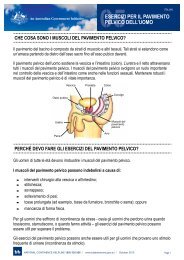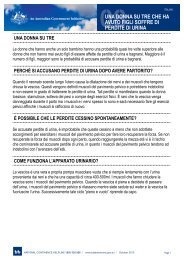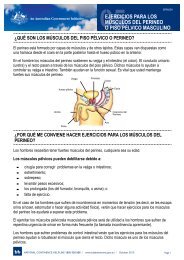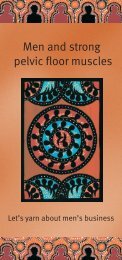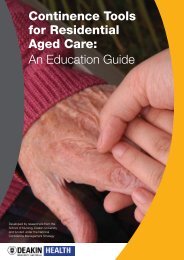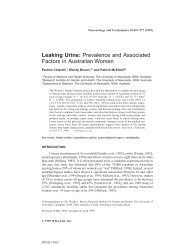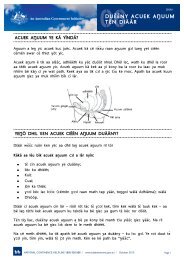Pharmacy Continence Care - Bladder and Bowel Website
Pharmacy Continence Care - Bladder and Bowel Website
Pharmacy Continence Care - Bladder and Bowel Website
You also want an ePaper? Increase the reach of your titles
YUMPU automatically turns print PDFs into web optimized ePapers that Google loves.
continence care. A template for a customer feedback questionnaire was provided in the<br />
training materials. Sixteen of the 32 respondents to the <strong>Pharmacy</strong> Exit Questionnaire (PEQ)<br />
had sought such feedback.<br />
Chapter 4, Outcomes <strong>and</strong> Effectiveness Evaluation, also discusses the effectiveness of the<br />
training of pharmacies <strong>and</strong> pharmacy assistants, assessed by self-administered interview of<br />
the participating pharmacies <strong>and</strong> by debrief interview of the contracted continence care<br />
trainers who provided face-to-face <strong>and</strong> group-based training of pharmacy staff. The chapter<br />
presents a summary of the results of the Pilot Program from the perspective of the<br />
participating pharmacies, <strong>and</strong> an analysis of the extent to which pharmacies reported the<br />
program as having enhanced their role, been cost-effective, <strong>and</strong> changed pharmacy<br />
behaviour. Pharmacies’ overall impressions of the effectiveness of the program are presented<br />
in summary. Outcomes for consumers are also presented.<br />
Chapter 5, Discussion, discusses strategies for the national roll-out of the program <strong>and</strong> for<br />
sustainability of this program as a new cognitive service for community pharmacies. This<br />
chapter discusses the method proposed for recruitment <strong>and</strong> training of pharmacies in a<br />
national roll-out, <strong>and</strong> the existing QCPP st<strong>and</strong>ards that are recommended as relevant to the<br />
<strong>Pharmacy</strong> <strong>Continence</strong> <strong>Care</strong> Program, providing the capacity for participants in the Program<br />
to acquire CQI points. The resource materials for training <strong>and</strong> for consumer information in an<br />
ongoing program are also discussed. Costs of the roll-out of a national program are<br />
identified, <strong>and</strong> potential sources of funding discussed. A communication strategy to engage<br />
pharmacies <strong>and</strong> achieve their participation, <strong>and</strong> to promote consumer <strong>and</strong> community<br />
awareness, is outlined. The chapter also identifies the potential for the program to provide<br />
an ongoing self-evaluation <strong>and</strong> to focus on consumer feedback <strong>and</strong> health outcomes<br />
assessment.<br />
Chapter 6, Recommendation <strong>and</strong> Implementation Plan, presents the conclusions <strong>and</strong><br />
recommendations of the project team.<br />
Appendix 1 to this report provides the detailed methodology, timelines, participating<br />
pharmacies, training materials <strong>and</strong> consumer materials, <strong>and</strong> the pharmacy <strong>and</strong> consumer<br />
participation surveys. Appendix 2 maps the content of the National <strong>Pharmacy</strong> Assistant<br />
St<strong>and</strong>ards to PCCP learner activities. Appendix 3 identifies the relevant QCPP st<strong>and</strong>ards for<br />
program implementation. Appendix 4 provides a summary of literature <strong>and</strong> training<br />
materials.<br />
Final Report<br />
5<br />
NOVA Public Policy<br />
<strong>Pharmacy</strong> <strong>Continence</strong> <strong>Care</strong> Project



